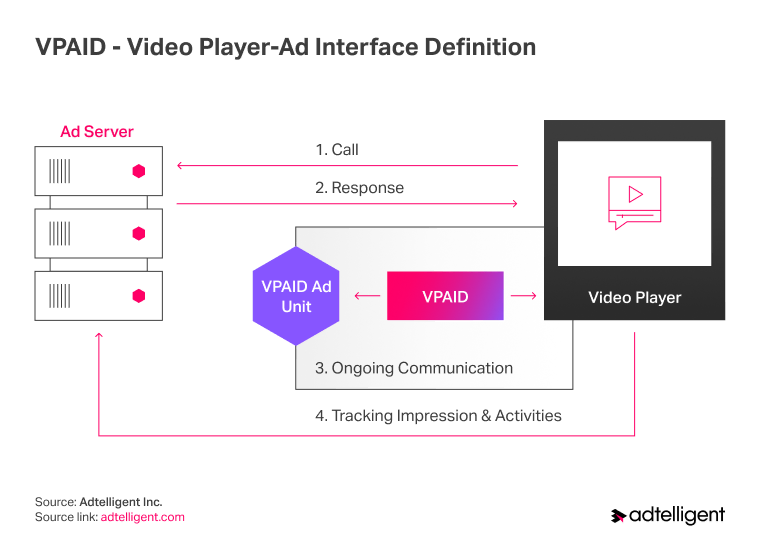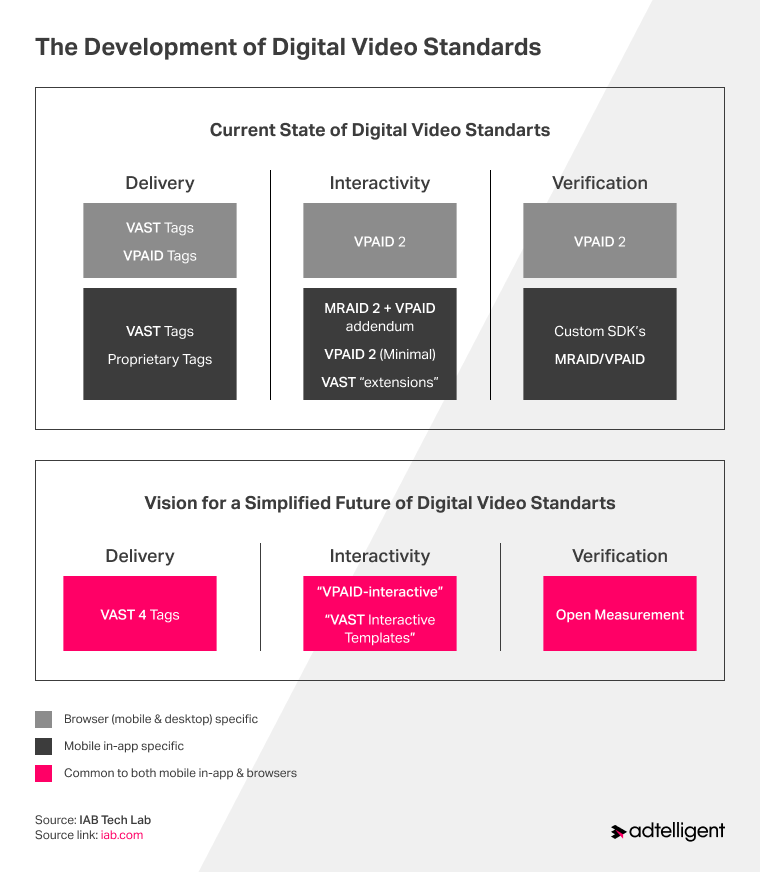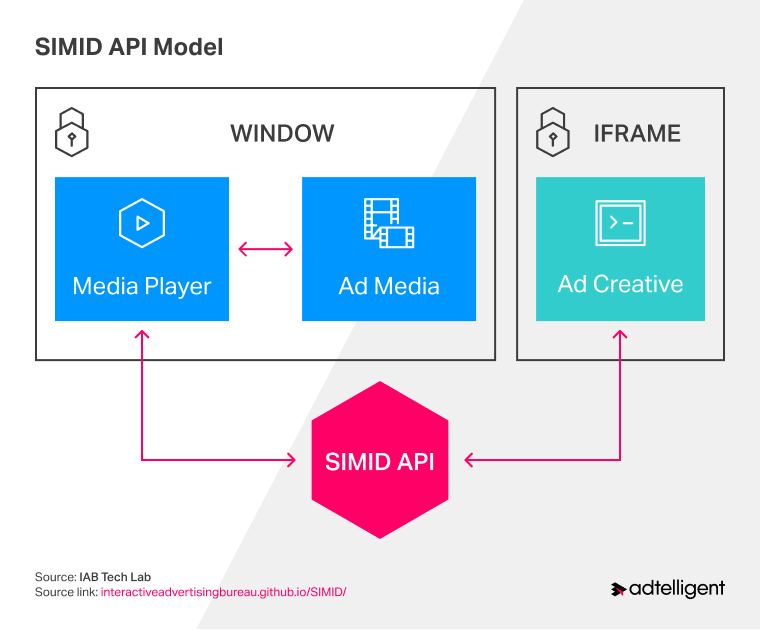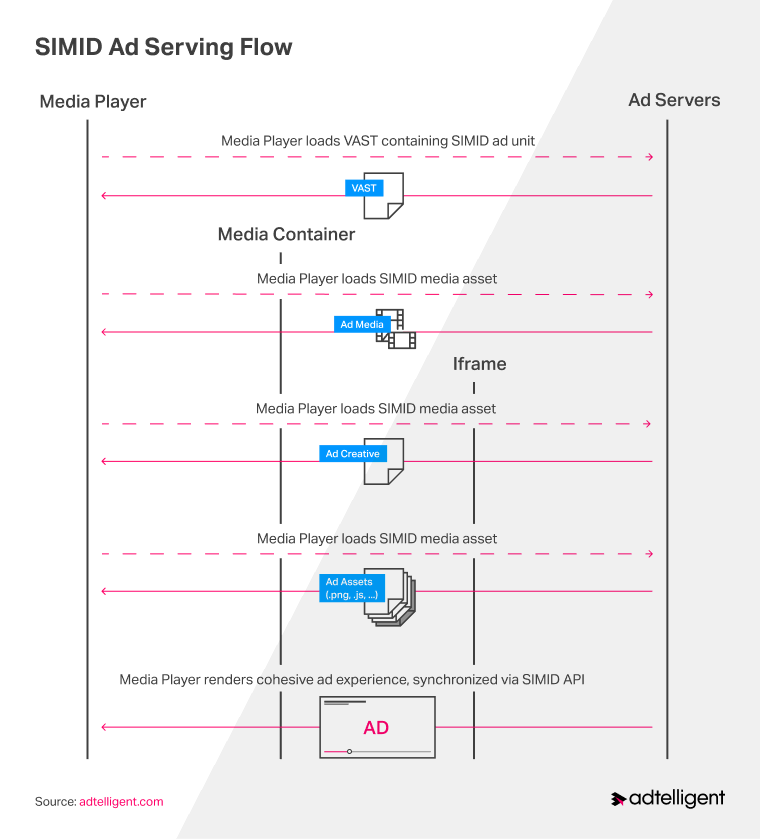SIMID, formerly known under the operating name VPAID-i, Secure Interactive Media Interface Definition (SIMID), is one of the successors of VPAID.
A brief history of VPAID
VPAID (Video Player-Ad Interface Definition) is a common interface connecting video players with ad units and providing an interactive in-stream ad experience. VPAID was first introduced by IAB Tech Lab back in 2012 and it has a lot of additional features that, for example:
- Clicks on different tabs in one ad;
- Zooming in and out;
- Embedding a questionnaire within an ad;
- Playing games in the video ad.
It also collects data on how viewers’ interact with advertising, providing more detailed statistics to marketers.

At the end of 2017, IAB announced its plans to abandon VPAID shortly. According to IAB Tech Lab, VPAID does not satisfy transparency requirements and has a string of disadvantages that come with its application. For example, publishers were reluctant to give up their ability to decide when videos start playing and how they look. Another reason for distrust was the difficulty publishers had found out where the ad came from.
The Introduction of SIMID
The plan was to leave the VAST to be used to deliver ads with a single tag to render ad units seamlessly across various platforms and to pre-cache video assets without latency issues. SIMID and OMID were in the works to solve these existing problems.
In 2019 VPAID was replaced with SIMID and OMID, a set of new standards for the video ad tech industry.

SIMID and OMID
What is SIMID?
SIMID stands for Secure Interactive Media Interface Definition and is responsible for interactivity; it is aimed to support safe, interactive ads in a transparent environment and ensures cross-platform support across mobile, SSAI, and OTT devices. It does so by separating the interactive layer from the media asset, which became possible with the VAST 4.0+ updates.

Benefits of SIMID
Compared to VPAID, the new SIMID standard provide such benefits:
- Higher data security;
- Improved asset transparency by including the media file in the VAST response;
- Highly interactive ads that work well across all platforms and devices;
- Publishers get more control of media/ad streams;
- Pre-caching;
- Fewer latency issues;
- User Experience is better;
- Better error reporting from more granular error codes.

These changes allow publishers to manage video streams better and enable server-side ad insertion (SSAI) and live streaming options. In addition, the latest SIMID (v1.1) upgrade instigated support for nonlinear ads, including a new sample code, media-player-managed clickthrough navigation for app environments, and a list of new error codes.

What is OMID?
OMID is an acronym for Open Measurement Interface Definition and is in charge of measurement and verification.
It gives advertisers access to various verification vendors through one single integration. In addition, it allows measuring viewability in a regulated way (unlike the VPAID). To let VPAID be leveraged for viewability, the ads needed access to the whole web page, bringing significant security risks as fraudulent third-party advertisers could also gain access to the page. IAB Tech Lab created OMID specifications to counteract these issues. IAB also created a software kit (SDK) to encourage the adoption of OMID and for the same implementations to be reused across the industry.
Benefits of OMID
- Easy access to viewability information and measurements;
- Clarity and simplicity with new structured standards;
- Better support across all verification vendors by allowing a single tag to work across a variety of platforms;
- Reduced the risk of errors;
- More seamless video experience;
- Better security and transparency.
Why do many publishers still use VPAID?
The general market is always hostile to new changes. Especially if the changes are big; we can see this in the example of third-party cookies cancellation. A similar tendency can be observed with the depreciation of VPAID as OMID and SIMID were introduced.
Overall, the consensus was supported by the big players first, as they have more means to implement novelties. However, it can take 4 to 5 years to adjust to such changes fully, and smaller companies would have more difficulties implementing them. In the case of OMID and SIMID, advertisers need to push and invest in new formats and standards, forcing publishers to rewrite their codes and make their video players compatible with recent changes. It takes time, money, widespread market demand, and many other factors.
VPAID is quite popular as it is a well-known technology that works and supports unusual formats but does not have RTB (s2s) connections to advertisers. Although many companies still use it to execute VAST tags to connect a server with advertisers. Adtelligent SSP also supports VPAID and is on its way to adopting new SIMID and OMID standards, testing them out in the trial mode.
Time to kill off VPAID and give publishers more control
While VPAID is a popular way for websites to get paid for displaying video ads, it’s been abused so badly that it’s become an issue. Constant delays, endless creative failures, and multiple redirects are causing the worst possible user experience and repeatedly low fill rates.
Besides this, there is massive potential for digital advertising on smartphones and tablets, which VPAID cannot support. Therefore we must consider standardizing, enabling, and planning for our entire industry with seamless, measurable ads running across all environments (desktop, tablet, smartphone).
To summarize – it will take some time to eliminate something that proved to be effective and observe the total adoption of new standards.